
Melville Island is an island in the eastern Timor Sea, off the coast of the Northern Territory, Australia. Along with Bathurst Island and nine smaller uninhabited islands, it forms part of the group known as the Tiwi Islands, which are under the jurisdiction of the Northern Territory in association with the Tiwi Land Council as the regional authority.

The Cobourg Peninsula is located 350 kilometres (217 mi) east of Darwin in the Northern Territory, Australia. It is deeply indented with coves and bays, covers a land area of about 2,100 square kilometres (811 sq mi), and is virtually uninhabited with a population ranging from about 20 to 30 in five family outstations, but without any notable settlement or village. It is separated from Croker Island in the east by Bowen Strait, which is 2.5 kilometres wide in the south and up to 7 kilometres in the north, and 8.5 kilometres long. In the west, it is separated from Melville Island by Dundas Strait. From Cape Don, the western point of the peninsula, to Soldier Point in the east of Melville Island, the distance is 28 kilometres (17 mi). In the north is the Arafura Sea, and in the south the Van Diemen Gulf. The highest elevation is Mount Roe in the south with an altitude of 160 metres (525 ft).
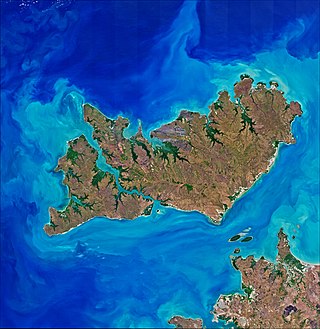
The Tiwi Islands are part of the Northern Territory, Australia, 80 km (50 mi) to the north of Darwin adjoining the Timor Sea. They comprise Melville Island, Bathurst Island, and nine smaller uninhabited islands, with a combined area of 8,320 square kilometres (3,212 sq mi).

Port Essington is an inlet and historic site located on the Cobourg Peninsula in the Garig Gunak Barlu National Park in Australia's Northern Territory. It was the site of an early attempt at British settlement, but now exists only as a remote series of ruins.
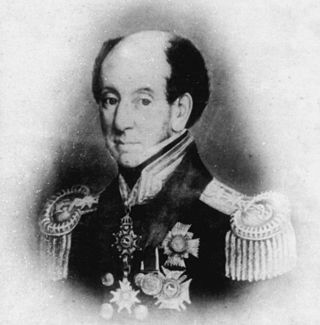
Sir James John Gordon Bremer was a British Royal Navy officer. He served in the Napoleonic Wars against France, the First Anglo-Burmese War in Burma, and the First Opium War in China.
The history of the Northern Territory began over 60,000 years ago when Indigenous Australians settled the region. Makassan traders began trading with the indigenous people of the Northern Territory for trepang from at least the 18th century onwards.

The Tiwi Islands Football League is an Australian rules football competition in the Tiwi Islands, Northern Territory, Australia.

Australian Football in the Northern Territory is the most popular sport, particularly with indigenous Australian communities in Darwin, Alice Springs and the Tiwi Islands. It is governed by AFL Northern Territory.
The following lists events that happened during 1824 in Australia.

The Tiwi people are one of the many Aboriginal groups of Australia. Nearly 2,000 Tiwi people live on Bathurst and Melville Islands, which make up the Tiwi Islands, lying about 48 kilometres (30 mi) from Darwin. The Tiwi language is a language isolate, with no apparent link to the languages of Arnhem Land on the Australian mainland. Their society is based on matrilineal descent, and marriage plays a very important part in many aspects of their lives. Art and music form an intrinsic part of their societal and spiritual rituals as the Tiwi people tend to follow a certain form of indigenous Animist belief system. The Stolen Generations saw many Indigenous people brought to the Tiwi Islands who were not of direct Tiwi descent.
Bremer Island, or Dhambaliya in the local language is an island in the Arafura Sea, in the northwest of the Gulf of Carpentaria, 3.4 km off the northeast corner of Arnhem Land, Northern Territory, Australia.
The Tiwi Land Council is a land council in the Northern Territory of Australia established in 1978 to represent Aboriginal Australians living on the Tiwi Islands.
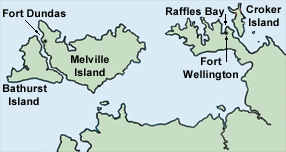
Fort Wellington was the name of a short-lived British settlement established in 1827 at Raffles Bay, on the northern side of the Cobourg Peninsula of what is now the Northern Territory of Australia, which was abandoned in 1829. It was the second of a series of four such abortive settlement attempts in Australia's Top End, the first being Fort Dundas (1824–1828) on Melville Island, the third Fort Victoria or Victoria Settlement, at Port Essington (1838–1849) on the Cobourg Peninsula, and the fourth at Escape Cliffs (1864–1867) near the mouth of the Adelaide River.

Escape Cliffs is a place on the northern coast of the Northern Territory of Australia, on the western coast of the Cape Hotham peninsula, and the eastern shore of Adam Bay, near the mouth and estuary of the Adelaide River. It lies about 60 km north-east of Darwin and is located in the Cape Hotham sector of the Djukbinj National Park. It was named by John Lort Stokes of HMS Beagle after visiting the spot in 1840, and refers to an incident where he and Lieut. Helpman escaped with their lives after being attacked by hostile Aboriginal men.
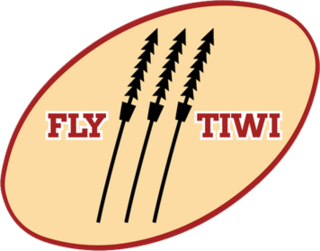
Fly Tiwi is an Australian airline based in Darwin, Northern Territory, offering scheduled passenger services between the Northern Territory capital and communities located on the Tiwi, South Goulburn and Croker islands, as well as a number of remote Arnhem Land communities. The company is wholly owned by the Hardy Aviation group, Australia's largest general aviation company, and was founded in 2008 in association with the Tiwi Land Council and, As of 2012 operates over 60 flights per week between 10 destinations.
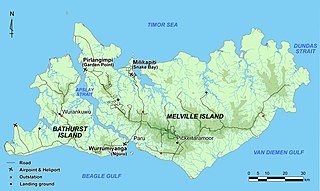
Pirlangimpi, formerly Garden Point, is a populated place on Melville Island in the Northern Territory, Australia.
The Iwaidja are an Indigenous Australian people of the Northern Territory.
Vernon Islands is a locality in the Northern Territory of Australia located over land and water in the Clarence Strait including the Vernon Islands and which is located about 55 kilometres (34 mi) north-east of the territory capital of Darwin.
Maria Josette Orsto was an aboriginal artist born at Pirlangimpi, on Melville Island. Her father, Declan Apuatimi, and her mother, Jean Baptiste Apuatimi, were also noted aboriginal artists from the Tiwi Islands. Orsto was one of the first female members of Tiwi Designs. Prior to her death she worked and lived at Wurrumiyanga on Bathurst Island.
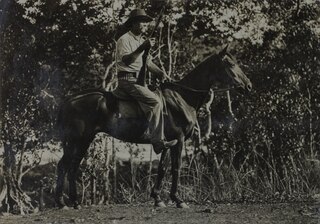
Robert Joel (Joe) Cooper was a buffalo hunter in the Northern Territory who spent much of his life on Melville Island (Yermalner).















